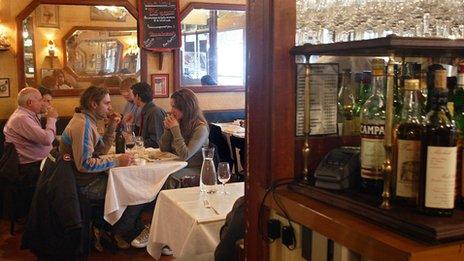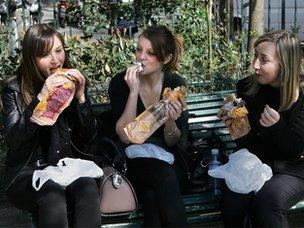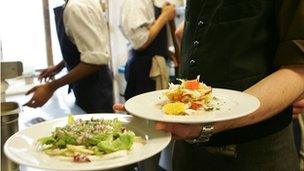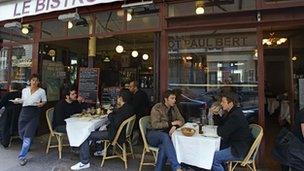The changing face of French lunchtimes
- Published

Some French workers are finding their lunchtimes too brief for the traditional three-course meal
On a sunny spring day, a bistro with a well-deserved reputation for first-rate traditional cooking is all but deserted at lunchtime.
"When the weather's good, people tend to grab a sandwich and eat outdoors," laments Otis Lebert, the owner and chef of Le Taxi Jaune in the trendy Marais district of central Paris.
A walk around the local park confirms his assessment. And there's a queue outside a nearby branch of the American sandwich chain, Subway.
The nation long known for three-course bistro lunches washed down with a glass of red wine is apparently turning to sandwiches, fast food and soft drinks.
Shorter lunch breaks
"About two billion sandwiches a year are sold in France," says food writer Franck Pinay-Rabaroust. "That means the French eat an average of 65 sandwiches per second."
The change is partly because French workers' lunch breaks have been drastically shortened. A recent survey found that the average is now 22 minutes, compared to an hour-and-a-half 20 years ago.
France's current economic woes also make office workers and professionals more reluctant to frequent their local bistro.
"Price is very important," explains Olivier Hays, general manager of Lina's, a sandwich chain which was started in Paris by a Franco-Lebanese family and prides itself on high-quality, made-to-order sandwiches.
"We are a French brand and we are a gastronomic fast food network," Mr Hays says. "We choose the best ingredients, everything is fresh, and our prices are much more affordable than the traditional bistros."
At one of Lina's outlets off the Champs-Elysees, many customers are eating ready-prepared salads. But according to Mr Hays, most French people stick with the old favourites. "Our best sellers are ham and cheese sandwiches," he says.
"These days, the notion that the French sit down to three-course lunches is a myth", says Mr Pinay-Rabaroust. "The reality is quite different. Less than 15% of meals served in France follow the traditional model of three courses which was honoured by Unesco."
Last year Unesco declared the "French gastronomic meal" to be part of the "intangible cultural heritage of humanity" and accordingly granted world heritage status to French food.
The decision followed intense lobbying. President Nicolas Sarkozy was certainly reflecting public opinion here when he declared, two years earlier, that French cuisine was the best in the world and should be recognised by Unesco.

A French lunch can't always be a formal affair
But Mr Pinay-Rabaroust says food habits are changing. "The very good lunch 'a la francaise' which people linger over, spending two, three or even four hours at the table, is in decline," he says.
But it isn't dead, at least not yet. On a good day, Mr Lebert's Taxi Jaune restaurant is packed with office workers, who come for a two or three-course prix fixe lunch, although few spend more than an hour there.
"Almost all my customers are regulars," Mr Lebert says. "It costs them a few euros more than a sandwich and a drink, but then they don't start snacking at five o'clock because the sandwich hasn't really satisfied them."
He holds the "master restaurateur" title awarded by the French government to restaurants where everything is freshly cooked on the premises by a chef whose skills are verified and recognised by local government officials.
The title is only awarded after repeated inspections. It was created in 2007 to enable people to distinguish between restaurants which buy ready-prepared ingredients and those which observe traditional gastronomic standards.
It was introduced because many restaurants in Paris now use processed or frozen ingredients instead of cooking from scratch. Many believe this is also contributing to the decline of the local restaurant and the rise of the sandwich.
For the adventurous, a sandwich in Paris doesn't have to be a baguette with a slice of ham or cheese.
At the Pain de Sucre bakery, passers-by stop to admire the colourful and artistic sandwiches and savoury pastries in the window.

Not all French workers want to wolf down a sandwich
One sandwich is called the Flamingo because it's made with focaccia bread coloured pink with beetroot. It contains goose rillettes, gherkins, trevisse (which is a variety of chicory leaf used in salads) and Granny Smith apple.
Another, called the Lou-Anne, is made with focaccia that has a greenish tinge because it's made with seaweed. The other ingredients include cream of sardine, rocket, smoked salmon and puree of black Kalamata olives.
But Didier Mathray, who runs the bakery with his partner Nathalie Robert, says their biggest seller is a humble ham sandwich, although the ham is a dry-cured gourmet variety and the bread is specially made.
"We don't use any artificial ingredients or colourings," he says. "We try to be imaginative and give our sandwiches a touch of extra creativity."
'Reinventing the sandwich'
Mr Mathray says sandwiches in France are becoming increasingly sophisticated.
"New sandwich outlets are opening all the time and they're competing to use the best products in an innovative way. That's raising standards across the board," he says.
Mr Pinay-Rabaroust agrees. "France, with its long gastronomic tradition, is reinventing the sandwich."

French people used to spend more than an hour lingering over lunch
And he points out that French people who eat sandwiches or fast food at lunchtime are also likely to frequent traditional bistros or three-star restaurants in the evening or at weekends.
"It's the same with burgers," he says. "Almost all French people go to McDonald's every now and then, but unlike the Americans, who go there at any time of day, the French mostly go at set times, between noon and two, and after seven in the evening."
In fact, they're treating it like a traditional restaurant, and McDonald's has recently introduced waiter service in one of its Paris outlets, clearly recognising that it needs to adapt to local demand in one of its most profitable markets. McDonald's is even planning to start selling ham sandwiches in France next year, says Mr Pinay-Rabaroust.
So the French are adjusting their eating habits to the faster pace of modern life, but they're also adapting fast food and sandwiches to suit their culture, tastes and lifestyle.